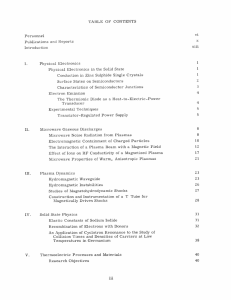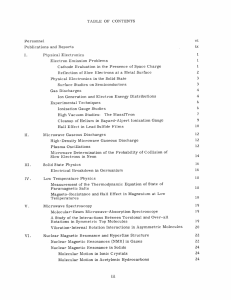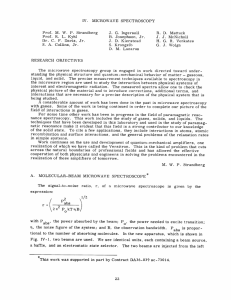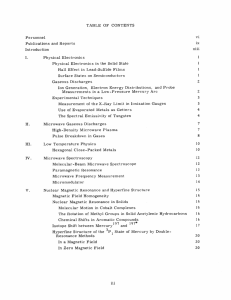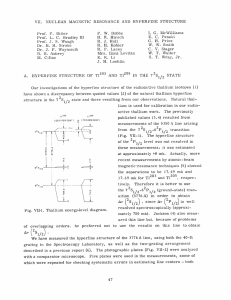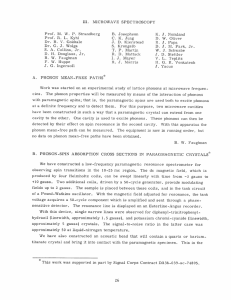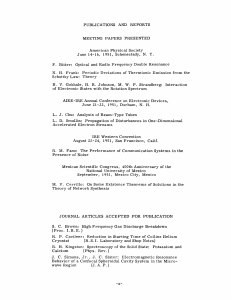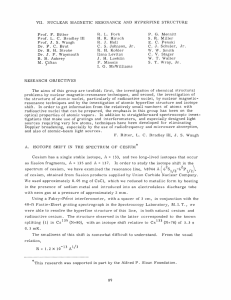J. G. Ingersoll
advertisement
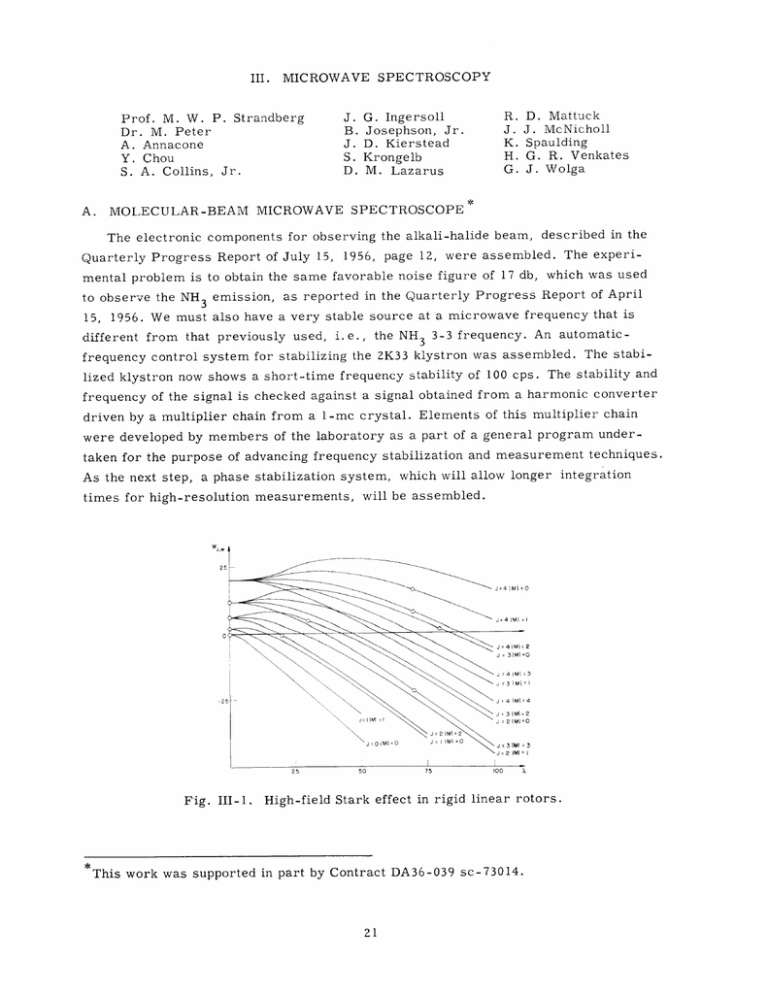
III.
MICROWAVE SPECTROSCOPY
Prof. M. W. P. Strandberg
Dr. M. Peter
A. Annacone
Y. Chou
S. A. Collins, Jr.
A.
R.
J.
K.
H.
G.
J. G. Ingersoll
B.
J.
S.
D.
Josephson, Jr.
D. Kierstead
Krongelb
M. Lazarus
D. Mattuck
J. McNicholl
Spaulding
G. R. Venkates
J. Wolga
MICROWAVE SPECTROSCOPE
MOLECULAR-BEAM
The electronic components for observing the alkali-halide beam,
Quarterly Progress Report of July 15,
1956,
page 12, were assembled. The experi-
mental problem is to obtain the same favorable noise figure of 17 db,
to observe the NH
3
described in the
which was used
emission, as reported in the Quarterly Progress Report of April
We must also have a very stable source at a microwave frequency that is
different from that previously used, i.e., the NH 3 3-3 frequency. An automaticfrequency control system for stabilizing the ZK33 klystron was assembled. The stabi15,
1956.
lized klystron now shows a short-time frequency stability of 100 cps.
The stability and
frequency of the signal is checked against a signal obtained from a harmonic converter
driven by a multiplier chain from a 1-mc crystal. Elements of this multiplier chain
were developed by members of the laboratory as a part of a general program undertaken for the purpose of advancing frequency stabilization and measurement techniques.
As the next step, a phase stabilization system, which will allow longer integration
times for high-resolution measurements, will be assembled.
J=4 IMI=0
J
41MI=2
J=4IMI3
J
J2
-25
31MI2
M1:4
J =2 IMI=I
25
Fig. III-1.
50
75
0
X
High-field Stark effect in rigid linear rotors.
This work was supported in part by Contract DA36-039 sc-73014.
(III.
MICROWAVE SPECTROSCOPY)
A check of the noise figure of the system is obtained by using a microwave bridge
circuit. One arm of the bridge includes the beam interaction region;
includes a
cell filled with a suitable test substance.
iodine cyanide,
which was prepared by Dr. C.
F.
the second arm
The actual test substance is
Davis,
of this laboratory. In order
to obtain better understanding of the focuser that was described in the Quarterly
Progress Report of Jan. 15, 1956, the Stark effect for rigid linear molecules for
arbitrarily high fields was calculated.
In Fig. III-1, the reduced energy W = E/hB is
plotted against the reduced field X = F4/hB. A formula which is asymptotically valid
for the high-field case is
W(J, M) = -x +i(2
+
-4 M
-
MI + 1) 11/2 +
+
6MJ
+
{[ M
+ 2 M J - 2J 2 +
6 MIJ2 - 4J 3 + 3M
2
M
- 2J - 2]
+ 6 MIJ - 6J 2 + 3IM - 6J - 2 X - 1/2
Drawings for a source that is twelve times larger than that presently available were
completed, and this source is being made in the Laboratory machine shop.
M. Peter
B.
PARAMAGNETIC RESONANCE
A program of study of F-center paramagnetic resonance in alkali-halide crystals
was initiated. Single crystals of NaCl, KC1, LiF, NaF, and KBr were irradiated and
colored by exposing them to 1. 1 and 1. 3 mev gamma rays from the Co 6 0 source of the
Department of Food Technology, M.I.T. Irradiation of 1-5 hours is sufficient to produce intense coloration. From an initial survey of the problem, resonances have been
obtained from NaC1, KCI, and LiF. Investigation is proceeding with the NaF and KBr
samples. Preliminary experimental results follow.
1. Lithium Fluoride
Investigation revealed a very intense center line with a resolved hyperfine spectrum
of 18 lines, giving a total of 19 resolved lines, in agreement with the results of
Schneider (1).
His analysis attributes the hyperfine structure to the six nearest neigh-
bor lithium ions with nuclear spin 3/2.
The main center line has a full width at half-
power of 41 gauss, assuming a Lorentzian line shape.
The hyperfine lines are separated
20-30 gauss and are symmetrically distributed about the center line. They appear to be
unequally spaced, but this conclusion must be investigated further. Work with lithium
fluoride continues.
(III.
2.
MICROWAVE SPECTROSCOPY)
Sodium Chloride
A resonance was observed in Sodium chloride, there is also evidence of a partially
resolved hyperfine structure on the line.
power of 21 gauss,
The strong center line has a full width at half-
assuming a Lorentzian shape.
Three hyperfine
lines symmetri-
cally located on either side of the center line were resolved. It is possible that the high
density of F-centers of this particular sample (judging from the intense coloration)
might have masked additional hyperfine structure.
narrower than that previously reported.
The observed linewidth is much
Kip and others (2) observed a full width at half-
power of 162 oersteds. They did not report any structure on their line.
Further in-
vestigation with less densely colored samples is planned.
3.
Potassium Chloride
A single resonance with uncertain indication of hyperfine structure was obtained.
The line has a full width at half-power of 7 gauss. The observed width is again much
narrower than was previously reported (2, 3), which was approximately 54 oersteds.
Further investigation with different potassium chloride samples continues.
4.
Program of Future Work
A systematic investigation of the general properties of the resonances in the various
alkali halides will continue. Samples of varying F-center concentrations will be prepared to see the effect of concentration on linewidth and hyperfine structure. A careful
analysis of the line shape will be made and evaluated.
The effect of saturation on the
resonances will be studied by variation of the incident microwave power density. In
particular,
the effect of power variation on the linewidth and hyperfine structure will
be studied. It is hoped that this work will yield information on the relaxation times T
and T Z .
G. J.
Wolga
References
1.
E. E.
Schneider, (abstract),
2.
A. F.
Kip, C.
3.
C.
C.
FREE RADICALS IN IRRADIATED CARBON BLACK
Phys. Rev. 93, 919 (1954).
Kittel, R. A. Levy, and A. M.
A. Hutchison, Jr.,
and G. A. Noble,
Portis, Phys. Rev. 91,
Phys. Rev.
87,
1066 (1953).
1125 (1952).
Workers in the field of rubber technology have noticed that carbon black which has
been irradiated with high-energy particles, on being mixed with rubber, provides a
higher amount of bound rubber than that produced by unirradiated carbon black. An
(III.
MICROWAVE SPECTROSCOPY)
explanation which postulated the creation of free radicals in the carbon black was proposed. The radicals result from broken carbon linkages as a consequence of the
radiation. To test this hypothesis, a paramagnetic -resonance study of irradiated
carbon black was made. Since the free radicals contain an unpaired electron, and,
consequently, a nonzero magnetic moment, they should show paramagnetic resonance
with a g-factor close to the free-electron value.
The results of this investigation sup-
port the hypothesis. A single, weak resonance absorption, with a half-width of approximately 20 gauss and a g-value close to the free-electron value,
showed the density of radicals to be - 1 X 10 14cm-3.
was observed and it
A control sample of unirradiated
carbon black did not show a resonance.
Samples of carbon black (1) irradiated with high-energy electrons from the High
Voltage Engineering Corporation' s Van de Graaf generator were examined immediately
and at varying times after irradiation. The strength of the absorption appeared to decrease with time after irradiation; however, there is a leveling-off of this decrease so
that the signal strength after a week' s time is roughly equal to that obtained after four
or five hours. This leveling-off might arise from two types of radicals, one of which
recombines soon after formation.
The peak absorption was compared with a known absorption in the oxygen molecule
(J = K = 1; AM = 1 -- 0) and from this the radical density was determined.
The resonant absorption described above is probably not the same as that described
by Uebersfeld (2) and Castle (3).
The difference may result from our measurements
being made at atmospheric pressure rather than in vacuum.
G. J.
Wolga
References
1.
2.
The samples were obtained from and irradiated by Dr. E. H. Immergut, of
Dunlop Research Center and Visiting Fellow, Department of Chemistry, M.I.T.
J. Uebersfeld, Ann. phys. (Mars - Avril 1956).
3.
J.
G. Castle, Jr.,
Phys. Rev. 92,
1063 (1953).
